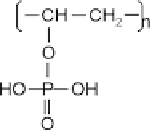Environmental Engineering Reference
In-Depth Information
Fig. 7.6
Reaction of PVA-boric gelation
there are two potential problems associated with the technique: cell damage in the
boric acid solution and PVA bead agglomeration [21, 53]. Several researchers mod-
ified the procedure to solve these problems, such as additions of calcium alginate
and activated carbon [53, 54].
The FPVA technique is based on physical cross-linking during temperature-
induced condition. Under cryotropic conditions, hydrogen bonds between OH
groups of the PVA polymer chain(s) occur either within the chain (intramolecu-
lar) or between two chains (intermolecular) [55]. Although this technique provides
a strong PVA cryogel, the freezing condition could affect cell viability.
Chen and Lin [21] developed a PPVA method that reduces the boric acid con-
tact time and consequently cell damage associated with the boric acid-PVA method.
This modified technique not only decreases the cell damage by boric acid but also
increases the strength and durability of entrapped cell beads. The PPVA technique is
a two-step droplet gelation method including spherical bead formation and harden-
ing. In the first step, spherical bead formation, the PVA-boron cross-linking occurs
according to the reaction shown in Fig. 7.6. In the second step, bead hardening,
spherical beads are left in a sodium phosphate solution to increase the surface gel
strength through PVA phosphorylation (Fig. 7.7) [56].
Procedures of Phosphorylated-Polyvinyl Alcohol Cell Entrapment
and De-entrapment
As mentioned above that BPVA and FPVA entrapment protocols may affect cell via-
bility, therefore, only PPVA cell entrapment is reviewed here. The following PPVA
cell entrapment procedure is according to Siripattanakul et al. [57]. The proce-
dure was modified from Chen and Lin [21] for preventing PVA bead agglomeration
during the PVA-boron cross-linking step. The modified cell entrapment procedure
begins with dissolving PVA in stirred DI at temperature of 60-80
◦
C and letting the
solution cool down to room temperature. Microbial cells are centrifuged at 4000
g
for 10 min and then mixed with the PVA solution. The mixture is dropped into a sat-
urated boric acid solution in a 1-l cylinder and remains in the solution for 30-45 min
×
Fig. 7.7
Structure of PVA
phosphorylation [56, p. 654],
Copyright (2004 and John
Wiley & Sons, Inc.);
Reprinted with permission of
John Wiley & Sons, Inc


